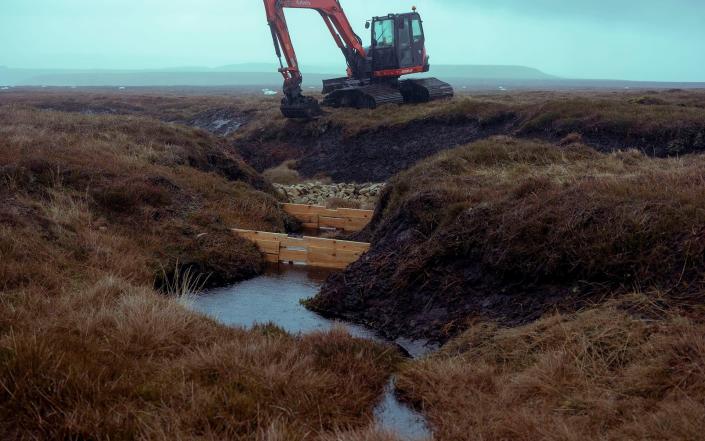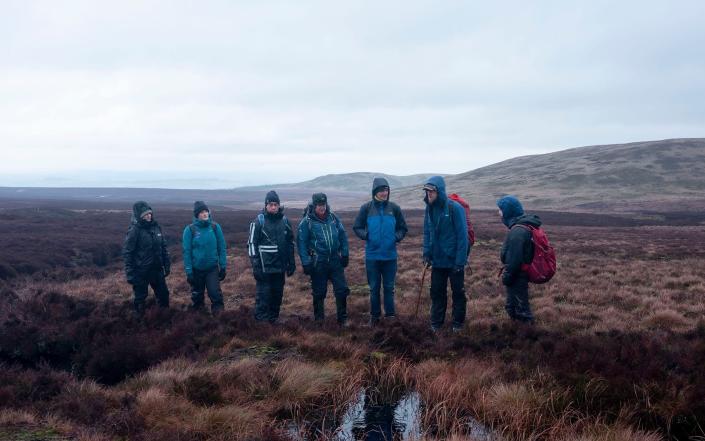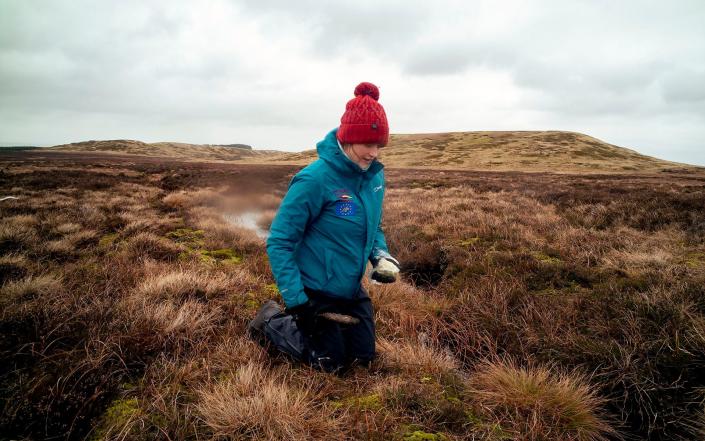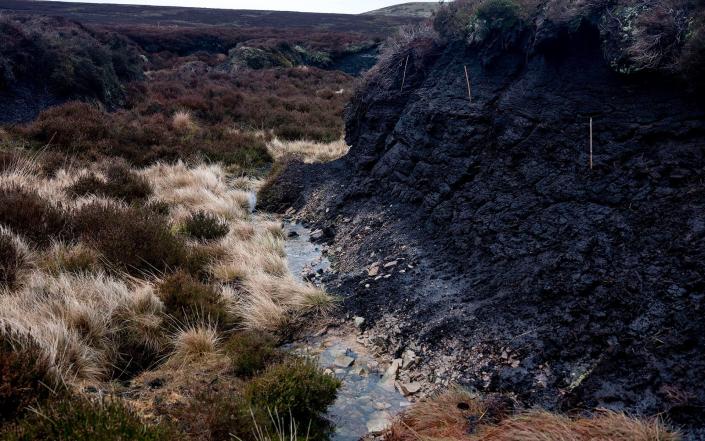Joe Shute
Sun, April 9, 2023

Alice Pearson and Tom Spencer of The Moors For The Future Partnership survey exposed peat - Alixandra Fazzina
Time moves in mysterious ways on the peat bogs of northern Britain. Here the black earth forms at just 1mm a year as it accumulates decaying organic matter. That means a layer of peat one metre thick contains roughly 1,000 years of history. Some blanket bogs have been recorded as 9,000 years old.
When in a denuded state, however – as an estimated 80 per cent of these landscapes across Britain currently are – what takes many lifetimes to build can disappear in an instant; millennia washing away in a single storm. We are crouched in a moorland gully in the South Pennines, inspecting the layers of the past that form this unique terrain. I am accompanied by Tom Spencer, research and monitoring officer for the Moors for the Future partnership, which for the past 20 years has worked to conserve the northern uplands.
The trench is a few metres wide and 3.5 metres deep, part of an expansive network running off the tops around Snailsden Reservoir and snaking like eels into the valley below. This should all be wet bog in its natural state: a gurgling morass of deep pools and sponge-like vegetation. Instead the erosion is so severe that great troughs have been cleaved through the dry peat. Melon-sized chunks of earth recently fallen away from the trench walls lie beneath our feet.
In the battle to save Britain’s peat bogs, this is the frontline. ‘Peat is being eroded from where we are sitting on all sides in all extreme weather conditions,’ explains Spencer. To illustrate his point, as he speaks the wind booms like artillery fire above our heads and a persistent rain soaks our clothes. ‘When it freezes, bits fall off. If the wind blows strongly you lose peat off the surfaces. If it rains really heavily there is water erosion and if you get a drought then it dries out and is lost as dust.’

Appearing like a bouquet, sprigs of pink, red and white sphagnum moss grow in the bed of the High Peak District - Alixandra Fazzina
Britain’s wetlands are the closest thing you will find to true wilderness on our small and cluttered isle. The UK holds between nine and 15 per cent of the total peatlands in Europe and around 13 per cent of all the blanket bog on Earth. It is estimated our peatlands store around three times more carbon than all our forests combined. In England alone, peat holds around 584 million tonnes of carbon (equivalent to five years of our total carbon emissions).
Wind-lashed and waterlogged, home to a vast array of internationally important flora and fauna and yet wild and inhospitable, these are the landscapes that encompass the span of British history, and the contradictions of our national psyche. For despite their ecological importance, Britain’s bogs have long suffered an image problem.
They are regarded as the badlands, a lawless wilderness roamed by bandits such as Magwitch in Great Expectations or (more recently) Happy Valley’s Tommy Lee Royce. They are places where dark secrets lie preserved in the naturally acidic soils and ghosts stalk the moors. Dartmoor has its hellhound; in the Pennines, Roman legions have been spotted on the march. The famous will-o’-the-wisp in folklore was an apparition that appeared over marsh gas to lure travellers to their death.
Now, however, Britain is being urged to finally fall in love with our bogs. The Government has placed peatland restoration at the heart of its Net Zero strategy, promising to restore 35,000 hectares of degraded peatland in England by 2025; in Scotland, ministers are promising to restore 250,000 by 2025. Key to this is the Great North Bog, a 10-year project between Moors for the Future and other partners to restore 7,000 square kilometres of upland peat across northern England.
The project, which encompasses five national parks and three areas of outstanding natural beauty, aims to inspire a national movement to embrace our uplands and recognise bogs as vital stores of carbon, as well as helping to prevent the increasing flooding, drought and wildfires.

Wooden and stone dams constructed to hold back water are placed along deeply eroded gullies of exposed peat at the site of regeneration works at Twizle Head - Alixandra Fazzina
Without these urgent restoration efforts, Britain’s peatlands will shift from being the solution to many of our modern-day problems to an aggravating cause. Already it has been estimated that peatland erosion in the UK currently releases around 23 million tonnes of carbon dioxide into the atmosphere every year, making it one of the key contributors to greenhouse gas emissions from land use. Unless we can reverse this, climatologists warn, Britain’s bogs will turn from a carbon sink to a ‘climate bomb’.
There are three types of peatland habitat across Britain: blanket bog, raised bog and fen. Over the centuries, each has suffered its own particular form of degradation. The lowland fens and marshes, in the main, were drained and converted into prime agricultural land.
The uplands of the Pennines have also suffered from extensive grazing, not helped by an ill-fated subsidy scheme in the ’60s and ’70s, which encouraged landowners to drain the moors to home more livestock. But principally, it is atmospheric pollution that has wrought the most damage upon this landscape. The South Pennines are sandwiched between the industrial powerhouses of Manchester and Sheffield. Over the 19th and 20th centuries coal smoke from their factories rose into the air as sulphur dioxide, and fell back as acid rain. This killed off many native plant species and, in particular, sphagnum moss, a miracle plant that holds up to 20 times its weight in water and comprises the building blocks of blanket bog.
Formerly lush hilltops were left bare and devoid of life. The fell walker and author Alfred Wainwright, whose guide to the Pennine Way was published in 1968 shortly after it opened as England’s first official national trail, described Black Hill in the Peak District as ‘a desolate and hopeless quagmire to the sky’. Of its bare summit and the others like it, he wrote, ‘this is peat naked and unashamed’.

Inspecting a peat dam in the rain, Telegraph Journalist Joe Shute meets with members from The Moors For The Future Partnership - Alixandra Fazzina
When Moors for the Future was established two decades ago, that is the landscape they were faced with, according to its head Chris Dean. Acid rain had burned off the vegetation on hilltops such as Kinder Scout and Bleaklow leaving behind bare, fissured peat with pH levels higher than lemon juice, upon which nothing could grow. He describes it simply as an ‘environmental catastrophe’.
It is not just carbon that is lost when a bog erodes. Deposited within the upper layer of the peat lies the toxic legacy of the Industrial Revolution in the form of heavy metals including lead, copper, zinc and arsenic. Microbiologists have even detected the presence of metal-eating bacteria up on the moors when typically they are restricted to urban scrapyards.
In a healthy state, peat keeps this locked away for eternity, but if not it is lost in the erosion. Recent studies have confirmed levels of zinc and copper detected in waterways above EU recommended thresholds. With an estimated 70 per cent of the UK’s drinking water collected from upland catchments, this is a major cause for concern.
Since 2003, Moors for the Future has been working to restore 35 square kilometres of blanket bog across the South Pennines and Peak District. And after many years of struggling to ignite enthusiasm for the project, there is suddenly considerable weight behind the work. Last year the Great North Bog project was awarded £9.3 million in Government funding. In total, Dean estimates, it will take £100 million.
Rishi Sunak has publicly stated his enthusiasm for re-wetting Britain’s uplands, not least because his Richmondshire constituency sits right in the heart of bog country. In a 2021 article for his local paper the Darlington & Stockton Times before becoming Prime Minister, Sunak wrote, ‘We have lots of peat in our Yorkshire uplands and this work – slowing the flow of water off the tops through dams and re-vegetation with heather and sphagnum moss – protects what is a vital environmental resource.’
Various pieces of legislation have also been introduced to protect moorland habitats. In 2021, heather-burning on grouse moors, a commonplace practice that exacerbates peat erosion, was banned on protected areas in England except in exceptional circumstances under licence. However, critics have pointed out that areas where the peat is less than 40cm deep can still be burned – and regularly is. Next year the sale of horticultural peat to amateur gardeners will be banned across England (to the delight of campaigners including Monty Don).

Alice Pearson of The Moors For The Future kneels with a trowel as she plants sphagnum mosses in the High Peak District - Alixandra Fazzina
Although in recent weeks the Government has infuriated environmentalists with the announcement that professional growers will still be able to use peat products until 2030. Once the damage has been halted, actually restoring a bog is relatively simple work and focuses on plugging the gaps and raising the water table. This is done by blocking gullies and creating moorland pools. Over winter, helicopters drop sacks of stones to use as dams and heather brash to protect vegetation. An army of staff and volunteers fan out across the moors planting thousands of plugs of sphagnum moss to help re-wet the landscape.
While in Snailsden, to illustrate what a poor quality bog feels like, Chris Dean urges me to jump up and down on the spot. The ground feels hard and hollow. In a healthy blanket bog the water table should be around 10cm from the surface, and a walker could sink up to their knees. It is this trepidation about what lies beneath, believes the US writer Annie Proulx, that has fuelled our destruction of bogs. The 87-year-old Pulitzer Prize-winning author of The Shipping News has recently published a global history of wetlands called Fen, Bog & Swamp. The book draws upon her own lifelong fascination with these waterscapes of myth and mystery and has been shortlisted for the UK’s Richard Jefferies award for outstanding nature writing.
‘There is that thing of fear which is at the top of the list as to how people feel about wetlands,’ she tells me over the phone. ‘I don’t feel that way but I think people are afraid of wetlands and resent them.’ Proulx insists that we must learn to set aside the antipathy of the past and embrace these ancient landscapes. ‘You have to seek them out but when you are there you can learn a tremendous amount about the world, your place in it, what we need and what we have lost.’
A body of evidence is accumulating as to the many benefits bogs provide. In September, Moors for the Future published the results of a six-year study conducted on Kinder Scout, the highest point in the Peak District, assessing the impact of 50,000 plugs of sphagnum moss it had planted on preventing flooding further downstream.
Before the restoration work, water would shoot off the surface of the bare peat and send upland streams racing down into the river valleys below. But the study found that the sphagnum moss reduced the so-called ‘peak flow’ of water after big storm events by 65 per cent, and increased by 680 per cent the time it took for rain to run off the hilltop.
These results were then computer modelled to apply to the wider valley and predicted that in intense storms there should be a 24 per cent reduction in peak flow affecting communities at risk of flooding. In more prolonged winter rainfall, that reduction would be between six and 12 per cent. ‘When we talk about the financial impacts of flooding,’ explains Tom Spencer, ‘really small margins make a big difference.’
In technical parlance this is known as Natural Flood Management (NFM) – restoring landscapes to make them more effective at holding back water and prevent it surging downstream. Traditionally somewhat overlooked by government funding models, which favour the more precise calculations of concrete defences, the potential of Britain’s wetlands is now increasingly forming part of our flood defence strategy.

This area of The Peak District is so badly scarred by water run-off it has become known as 'the trenches' - Alixandra Fazzina
In December, the Environment Agency published the results of a four-year £15 million study analysing 60 NFM pilots across England. As well as significantly reducing flood risk – collectively the pilots slowed and stored water upstream of 15,000 homes in flood-risk areas – the restored wetlands led to a cascade of other benefits, including creating or improving 610km of river habitat, 4,000 hectares of other habitat deemed beneficial to nature, and planting 100 hectares of woodland.
According to Julie Foley, director of flood risk strategy and national adaptation at the Environment Agency, they are now working on a target to double the number of natural flood management projects from 130 to 260 before 2027.
‘We are working with Government to look at ways in which we can look at funding rules to better reflect the benefits of natural flood management so it can become the first choice rather than the second choice,’ she tells me. Britain’s bogs, she adds, are places of ‘huge potential’ increasing our resilience to wildfires and summer droughts.
One ongoing challenge of peatland restoration, explains Dean, is the difficulty in showing people the benefits. Unlike say, a large-scale tree-planting programme, a re-wetted moor can be somewhat underwhelming to the untrained eye.‘If we’ve done it right, there is nothing to see,’ he admits. ‘We can spend a million pounds on a hillside and five years later people can look at it and ask, where did that go?’
To truly appreciate a bog, you have to look down. Here lurking in the dark treacle water lies an astonishing variety of plants: the brilliant green constellations of sphagnum moss, orange fruits of cloudberry and even the carnivorous sundew, which traps insects in its sticky secretions.
Healthy wetlands attract rare heathland butterflies and red-listed specialist wading birds such as curlew and lapwing. In parts of the Peak District, mountain hares still lope over the moorland grass. This is what happens when we embrace our bogs, Dean insists: a lost world envelops the mire.
No comments:
Post a Comment